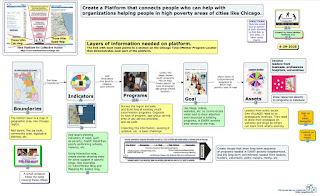I'm always looking for websites showing uses of maps to focus attention and resources on many locations where people need extra help. Below is the Cook County Digital Equity Map.
You can find the map here. Click here to find information about how the IMPACT Small Grants Program is providing funding and storytelling support to local nonprofits, media organizations and libraries throughout Cook County.
Join in the on-line Chicago Hack Night presentation this coming Tuesday (Nov 4, 2025) at 7pm and learn more about this program and an IMPACT Small Grants Program. If you can't make the live presentation all Chicago Hack Night events are recorded so you can watch them later.
City Bureau is partnering with the Cook County Board on this IMPACT Small Grants Program.
As you look at the Cook County map, look at this visual essay that I created in 2015 to show ways to use maps to focus attention and resources on EVERY high poverty area of Chicago and its suburbs.
In this presentation I show maps of Cook County Commissioner districts, along with other political districts, like Chicago Aldermanic Wards and Illinois State Legislative districts.
Below I show maps of Cook County Commission Districts 2 and 3, and shootings that took place in their districts.
I did not see a feature on the Digital Equity map that sorts the information by district. How can Commissioners be held accountable if voters can't see where people need help, and where help is going?
I'd love to see maps on websites of every elected official that mirror the thinking I share in this visual essay. It shows a collaboration across districts, focusing on shared geography, and shared commitment to helping people who need extra help.
Maybe this is being done somewhere. If you know of such sites, please share the link. If not, share my presentation with elected officials and encourage them to build a platform with this functionality.
Thanks for reading.
I've been sharing this message for over 30 years, but far too few people have seen it and thus, too few are applying the ideas. You can help, just by sharing my posts.
Connect with me on LinkedIn, Instagram, Facebook, BlueSky, Twitter and other platforms. Find links on this page.
If you value what I'm sharing, please chip in to help me pay the bills. Visit this page.





























